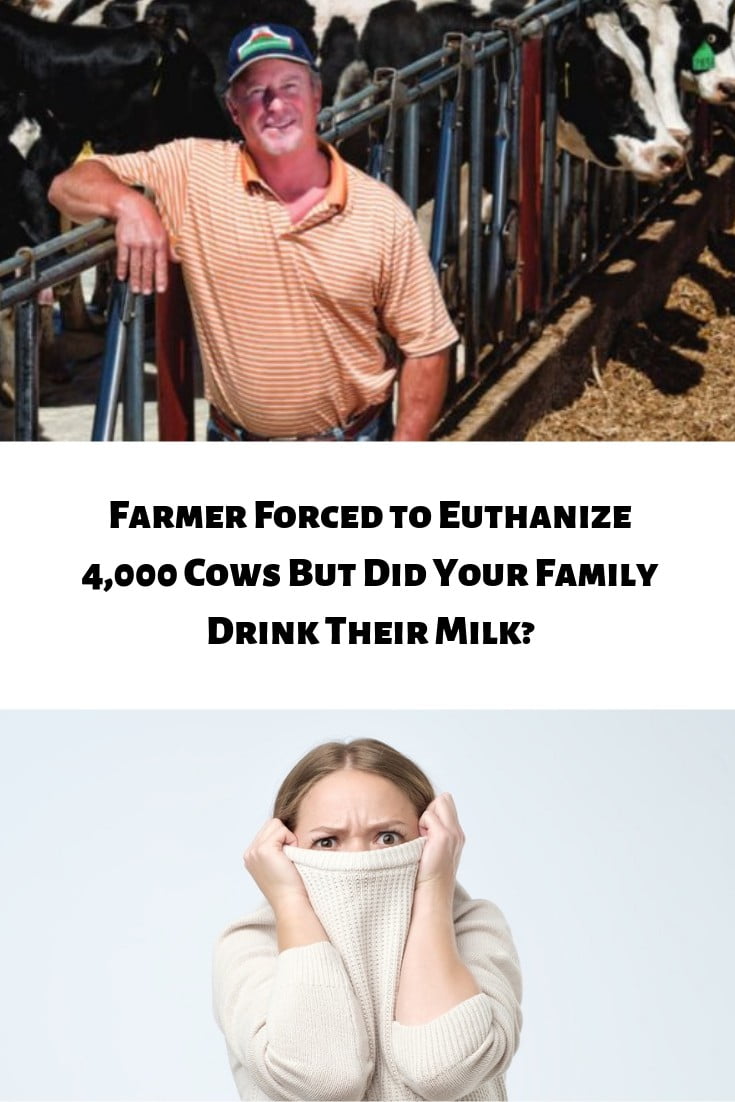Farmer Art Schaap, owner of Highland Dairy in Clovis, New Mexico is being forced to euthanize over 4,000 cows because they are contaminated with a dangerous chemical linked to infertility, weight gain, and cancers. But it’s important to understand that these same chemicals are also in other products inside your home. Mamavation wants to help you avoid them so you can safeguard your family from the health problems they are associated with. You’ve trusted Mamavation to cover topics like safest cookware, safest small kitchen appliances & safest car seats for infants, now join us as we tell you the story about a farmer in New Mexico who had his life destroyed by dangerous chemicals. And stick around as Mamavation goes over how to avoid this chemical in other areas of your home.
Disclosure: This post contains affiliate links. If you click and purchase a product we recommend, you are not charged any additional amount, but it does support the work we do here at Mamavation. Thank you!
Table of Contents
Farmer Fires Workers, Dumps 15,000 Gallons of Milk Per Day & Finally Decides to Euthanize 4,000 Cows
To say that farmer Art Schaap is having a bad day is the understatement of the year. He’s had to lay off 40 employees, dump 15,000 gallons of milk per day, and now needs to euthanize all 4,000 of his cows. And that’s because the water his animals and his family have been drinking come from wells contaminated with per- and polyfluoroalkyl substances (PFAS). This chemical contamination inside the wells originates from the firefighting foam used by Cannon Air Force base in New Mexico. The practice using PFAS chemicals to fight grease & chemical fires in firefighting foam is controversial because safer alternatives are available that other countries are using successfully. And yet chemical lobbyists have manipulated a ruling that all Federal bases must use them.
The health effects of Farmer Schaap’s family and workers are unknown. Farmer Schaap tested his blood to find eight to 10 times the normal levels of PFAS inside his body. His employees and wife are also likely to have elevated levels of this dangerous chemical inside them as well. And how does he feel about it?
“This has poisoned everything I’ve worked for and everything I care about,” says Schaap. “I can’t sell the milk. I can’t sell beef. I can’t sell the cows. I can’t sell crops or my property. The Air Force knew they had contamination. What I really wonder is, why didn’t they say something?”
The Dairy Business reported recently that Farmer Schaap has filed a suit against 3M, the same company that created the chemicals found contaminating his wells. 3M recently lost a similar lawsuit for $850 million to the state of Minnesota for contamination.
How Do Farmer Schaap’s Chemical Problems Affect My Dinner?
Before Schaap’s Highland Dairy was informed of the contamination problem, his milk was bought and sold, mixed in with other dairies, crossed state lines, and consumed in quantities that are unknown. This thought horrifies Schaap who says “It’s potentially been in the groundwater the whole time I’ve owned the dairy.” What this means is the more farmers that are impacted by PFAS contamination in their groundwater and well water, the more likely we will find PFAS on our dinner plate. So this issue impacts everyone.
What are PFAS Chemicals & How Do They Affect Our Water & Food Supply?
What is happening to Farmer Schaap isn’t an isolated event. Millions of people around the United States are being impacted by PFAS chemicals in their water supply right now, especially in places like New York, Michigan, Pennsylvania, & Washington. Do you remember Teflon pans, Gortex clothing, StainMaster carpet, & Scotchguard coated furniture? These brands are examples of products that used PFAS chemicals to provide waterproof, stain resistance, & grease resistance to millions of Americans. But they were also used in fire fighting foam which is how most of it is getting into the water supply.
PFAS, aka perfluorinated chemicals, are persistent and incredibly toxic and have contaminated groundwater in certain areas of the United States. And because they are persistent, they build up in your body for decades before you can naturally get rid of them. Being exposed to trace amounts of PFAS chemicals over time adds up very quickly.
Here’s a list of ailments that are linked to PFAS chemicals:
- low sperm count
- smaller penis size
- reduction in immunity
- metabolic diseases like obesity & diabetes
- reduced vaccination response
- affect the growth, learning, and behavior of infants and older children
- lower a woman’s chance of getting pregnant
- interfere with the body’s natural hormones
- increase cholesterol levels
- increase the risk of cancer like testicular, prostate and breast cancers
PFAS chemicals can get into our water supply from industry, firefighting foam, & contaminated food packaging. Contaminants go from water to food by being consumed by animals, crops & people who live in the surrounding area.
Washington State Moves to Ban PFAS Chemicals in Food Packaging & FireFighting Foam
Washington State is an example of a community that has struggled with the contamination of PFAS in their water supply. In the communities of Coupeville, Issaquah, and Airway Heights, PFAS chemicals became a big problem in the water. It was so bad in the City of Issaquah that they spent more than $1 million on a water filtration system that would remove most of the contamination. Later, Washington passed two pieces of legislation to start to address the problem state-wide. First, they passed a bill banning PFAS in food packaging provided alternatives exist. Under this new law, Washington’s Department of Ecology (WDOE) has until January 1st, 2020 to determine whether there are safer alternatives to use. If safer alternatives in packaging are found and are available for businesses to purchase, a ban will take effect on January 1st, 2022. The second piece of legislation addressed firefighting foam in every agency but ones that are regulated by the Federal Government. We encourage you to contact your local, state and federal representatives to voice your concerns about this issue.

Products Containing PFAS Inside Your Home
To avoid PFAS chemicals from contaminating your family, there are several areas of the home you will need to tackle. I have to warn you this is a very big list, but it’s important to understand that persistent chemicals should have priority in what you decide to avoid. You don’t need to do it all at once, but it’s important to always strive to improve.
Water
Most water districts are aware of this growing problem and states and water districts are starting to study and test. Your local water district may be in the process of testing right now. And you are always welcome to ask them. Some will make information public while others will not. But it’s important to know that they have not been mandated yet to address this, so they need direction from local, state and the federal government first. However, groundwater contamination is already starting to pop up in communities surrounding airports, industrial parks, and military bases.
To find out if your water is contaminated with PFAS try thinking about answering the following questions first
- Do you live by an army, navy, & air force base? The polluted ones are here.
- Do you live close to an airport? Check your local water district to inquire about contamination.
- Do you live close to industrial facilities that use chemicals? Check with your local water district to inquire about contamination.
If you would like to look into water filter, we recommend you read about our favorite water filters for the home.
Nonstick Pans
Our cookware investigation did not find any safe nonstick pans, because most “nonstick” pans are coated with PFAS chemicals. We also found most of the ceramic cookware to be just as problematic. The reasons behind that are the glazes used to coat most ceramic pans are made of nanoparticles and studies have shown the migration of these nanoparticles into the food. We recommend stainless steel, cast iron, glass cookware without coatings and glazes. Please follow the recommendations in this post to avoid the coated stainless steel and cast iron, which is not what you want.
The only safe ceramic brand we found was Xtrema Cookware, so we reached out to them to get a discount for you. Get an EXTRA 15% Xtrema Off with code USA15.
Small Kitchen Appliances
Our small kitchen appliance investigation found some similar problems as we found in cookware. The nonstick surfaces contained PFAS chemicals, which are very problematic. We also found lots of ceramic surfaces as well. The Mamavation-approved products do not consist of PFAS, ceramic, polycarbonate (BPA), polystyrene, HDPE, PET or Tritan because they’ve all tested positive for estrogenic activity (EA) or leaching of toxic chemicals. We looked at blenders, coffee makers, pressure cookers, slow cookers, multi-cookers, food processors, mixers & choppers, air fryers, waffle makers, griddles, baby food makers & dehydrators.
Food Packaging–Disposable Foodwares like Plates & Trays
Please pay close attention to our investigation on disposable plates and trays. The Center for Environmental Health lab-tested hundreds of disposable plates & other foodwares to find which brands contained PFAS. There were some surprising results where “eco-friendly” companies were caught red-handed. We took that list and combined it with a list we have of other contaminants inside disposable plates and came up with an ultimate product listing for you.
Dental Floss
If you use Oral B Dental Floss of one of these other brands, you need to throw them away. The Silent Spring Institute lab-tested dental flosses and found that people who used particular products had a higher level of PFAS in their body. Make sure you avoid any of the products in this post that are linked to PFAS.
Furniture & Mattresses
Our investigation of mattresses & furniture will be helpful to you the next time you are in the market for a bigger ticket item. Those expenses are a bit more and may not be purchased or changed as easily, but we are here for you when you are. But what you really want to be aware of is avoiding anything that is “stain-resistant” because those are PFAS chemicals.
Clothing
Avoid any type of clothing that has any attributes of “stain resistance” or “water resistance.” This is a tough one because it hits you in the cold and rainy weather. This list includes ski jackets, trousers, backpacks, tents, etc. Green Peace found PFAS chemicals in the following brands by category:
These jackets tested positive for PFAS:
- North Face
- Patagonia
- Adidas
- Columbia
- Jack Wolfskin
These swimsuits tested positive for PFAS:
- Disney
- Burberry
These shoes tested positive for PFAS:
- Nike
- Adidas
- Puma
List of Things to Avoid To Slay PFAS In Your Home
- Avoid nonstick pans. Try these instead.
- Avoid microwave popcorn and air pop instead
- Avoid these dental floss brands
- Avoid fast food and fast casual food wrappers
- Avoid small kitchen appliances with nonstick surfaces
- Be wary of beef or dairy from Michigan, New York or Pennsylvania where contamination has been severe
- Avoid carpet with stain resistance
- Avoid furniture with stain resistance
- Avoid mattresses with stain resistance
- Avoid clothing with stain resistance or any textiles made with the original (pre-2000) formulation of Scotchgard
- Avoid personal care products with “PTFE” or “fluoro” ingredients
- Avoid water from wells testing positive for PFAS














 How to Make Your Own Homemade Kombucha Tea In Your Kitchen
How to Make Your Own Homemade Kombucha Tea In Your Kitchen
The Center for Environmental Health lab-tested hundreds of disposable plates & other foodwares to find which brands contained PFAS. There were some surprising results where “eco-friendly” companies were caught red-handed. We took that list and combined it with a list we have of other contaminants inside disposable plates and came up with an ultimate product listing for you.